Fernando Botero
Fernando Botero was born April 19, 1932, in the province of Antioquia in Medellín, Colombia to parents Flora Angulo Jaramillo and David Botero Mejía, a traveling salesman. At the age of 12, his uncle Joaquín Angulo sent him to the bullfighting school in the center of Medellín. During this period, he spent most of his time drawing scenes of the Fiesta Brava, particularly the bullfights. He participated for the first time in a collective exhibition in 1948 called Antioquian Painters in Medellín and created illustrations for the Sunday supplement of the newspaper El Colombiano.
From his youth, Botero was impressed by the richly ornamented colonial baroque style of the churches and monasteries in Medellín and its surrounding area. He was also eager to learn more about Modern art in Europe. In 1949, he enrolled in Liceo San José in Marinilla, Colombia but was suspended shortly thereafter for writing the article Pablo Picasso and Nonconformism in Art, which was considered controversial for the time. A month later, he wrote a paper about surrealism and Salvador Dalí, Anatomy of Madness, emphasising the artistic renewal that surrealism represented. The influence of Mexican painters José Clemente Orozco, Diego Rivera and David Alfaro Siqueiros are reflected in some of his drawings, such as in Mujer llorando (Crying Woman).
He was awarded second prize in the Ninth Annual Art Exhibition of Colombian Artists in Bogotá for his painting Frente al Mar (The Waterfront) and decided to use the prize money to travel to Europe. After a short stay in Barcelona, he went to Madrid and enrolled at the San Fernando Royal Academy of Fine Arts. He studied the works of great Master artists such as Velázquez, Goya, Titian and Tintoretto at the Museum of El Prado.
His first exhibition in the United States, entitled ‘Fernando Botero’ was held at the Pan-American Union in Washington, DC in 1957. He visited several museums in New York and discovered abstract expressionism. He returned to Bogotá and received second prize at the Tenth Annual Exhibition of Colombian Artists for his work Contrapunto (Counterpoint). He was appointed professor at the Academy of Fine Arts of the National University of Colombia, where he taught painting until 1960.
After one of his visits to Germany in 1967, his continued fascination by the work of German artist Albrecht Durer led him to the creation of Dureroboteros, a series of large charcoal-on-canvas pastiches which improvised on the German Master. During this year, he began to study the paintings of French impressionist Édouard Manet, repeatedly interpreting The Luncheon on the Grass in his own style.
The colombian artist exhibited a series of paintings and charcoal drawings at the Center for Inter-American Relations in New York, a collection that positioned him as one of the most important Latin American artists. He also carried out his first exhibition in Paris, at the Claude Bernard Gallery, where he later settled and decided to venture into the field of sculpture and used bronze for his first pieces.
Soon after he had his first retrospective exhibit in Bogotá, with works from the period between 1948 and 1972, his youngest son Pedro was killed in a car accident in Spain. This tragedy was a turning point for his works from that moment on. Botero created his sculpture Mano (Hand), which is considered one of his most important bronze pieces.
He donated his work Prayer to the Museum of Antioquia in Colombia, the first of many donations he made to this museum and many other Colombian insitutions thoughout his life and career. The magazine Poder named Botero as the “Philanthropist of the year” in 2008 at the Global Philanthropy Forum held in Miami, in recognition of all the donations he had made throughout his life to the people of Colombia.
Botero gave three of his monumental sculptures to San Antonio Park in Medellín, as well as eighteen paintings to the National Library of Bogotá. He donated the entirety of his collection of Contemporary art amassed over twenty years, in addition to over a hundred of his oil paintings, drawings and sculptures. This prompted the creation of Donación Botero, a museum which holds works of nineteenth and twentieth century artists such as Pissarro, Corot, Monet, Renoir, Picasso, Degas, Matisse, Beckman, Bacon, Dalí, Lucien Freud and many others. He delivered twenty-one works of contemporary artists such as Rosenquist, Wesselmann and Katz along with 114 of his own to the Museum of Antioquia in Medellín.
The latin american artist dedicated a lot of his work to the exploration of bullfights in Spain. In 1985, the Marlborough Gallery in New York presented a series of twenty-five bullfighting works. The exhibition ‘Botero: Bilder, Zeichnungen, Skulpturen’ (Botero: Pictures, Drawings, Sculptures) was displayed in Munich, Bremen and Frankfurt.
Botero also started a series of paintings based on cases of abuse and torture of the prisoners in Abu Ghraib’s prison, in Iraq. He donated forty paintings and drawings, part of a series focused on violence in Colombia, to Colombia's National Museum and gave the entire collection of twenty-five paintings and twenty-two drawings which focused on this theme to the Berkeley Art Museum in 2007. This same year, he also donated some of these works to American University as well as a set of one hundred and forty-eight paintings and drawings to the National Museum of Colombia. He continued to create work with a focused on the violence in his home country with a collection of paintings and drawings which focused on the circus in Abu Dhabi (UAE), Abu Ghraib - El circo (Abu Gharib - The circus), which was exhibited in the Spanish cities of Vigo and Valencia. He continued to exhibit his paintings of the series Abu Ghraib the following year in Monterrey, Mexico.
In 2009, a group of entrepreneurs in Mexico bought the bronze monumental sculpture Caballo (Horse) and donated it to the federal government so it could be exhibited in the Macroplaza. During this period, he was awarded with an Honoris causa doctorate by the Autonomous University of Nuevo León.
He donated 61 of his works of the series Vía Crucis: La Pasión de Cristo (Way of the Cross: The Passion of Chirst), to the Museum of Antioquia. Among them were 27 oil paintings and 34 drawings. In April 2012, many museums around the world celebrated Fernando Botero’s eightieth birthday by organising exhibitions to commemorate this date such as the Museo Palacio de las Bellas Artes in Mexico City there was an exhibition entitled: ‘Fernando Botero: Una celebración' (Fernando Botero: A celebration). It was the largest retrospective of his work up to that date, curated by Lina Botero, with 177 works and 5 monumental sculptures.
On the 15 September 2023, Botero passed away at his residence in Monaco at the age of 91. His work had a profound influence on the international art scene. This impact is exemplified by the monumental sculptures the colombian artist created for public spaces in many major cities, including New York, Paris, Rome and Monte Carlo.
His works are found in many important private and public collections, such as the Hirshhorn Museum and Sculpture Garden, Smithsonian Institution in Washington, D.C., USA; Ho-am Museum in Seoul, South Korea; Israel Museum in Jerusalem, Tel Aviv Museum of Art in Tel Aviv, Isreal; Kunsthalle Nuremberg in Nuremberg and Neue Pinakothek and Staatgalerie Moderne Kunst in Munich, Germany; Museo d'Arte Moderna del Vaticano in Rome, Italy; Museum Moderne Kunst in Vienna, Austria; The Metropolitan Museum of Art, The Museum of Modern Art, and The Solomon R. Guggenheim Museum in New York, USA. In 2024, Fernando Botero was the subject of a major retrospective at the Palazzo Bonaparte in Rome, Italy.

SELECTED WORKS
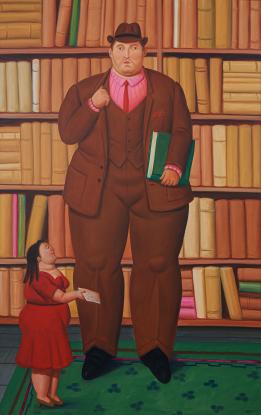
Fernando Botero, Lawyer and Secretary, 2010
Oil on canvas
206 x 129 cm | 81.1 x 50.8 in
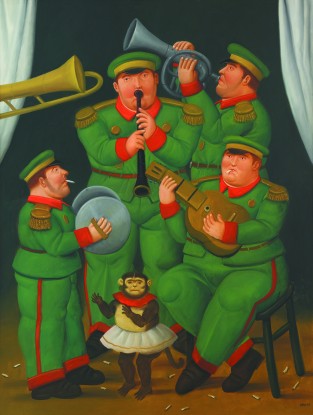
Fernando Botero, Circus Band, 2008
Oil on canvas
185 x 141 cm | 72.8 x 55.5 in
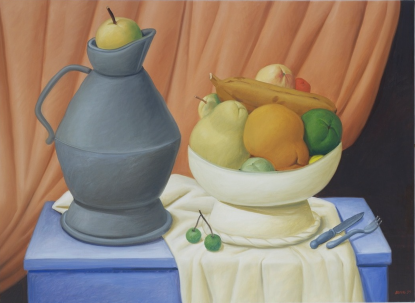
Fernando Botero, Still Life with Fruit Bowl, 1999
Oil on canvas
98 x 135 cm | 38.6 x 53.1 in
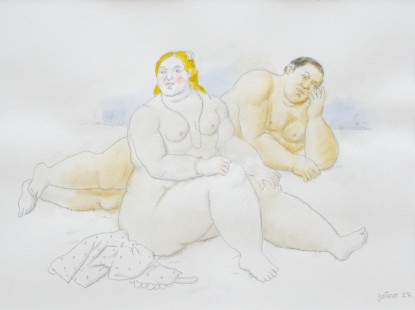
Fernando Botero, Man and Woman, 2022
Watercolour and pencil on paper
30,9 x 40,6 cm | 12.2 x 16 in
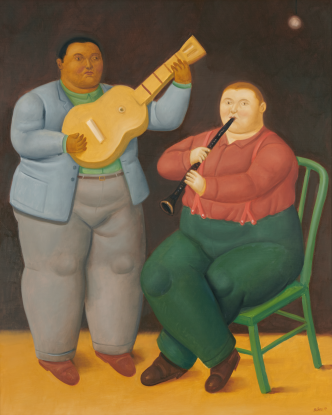
Fernando Botero, Músicos, 2017
Oil on canvas
119 x 96 cm | 46.9 x 37.8 in

Fernando Botero, Leda and the Swan, 2006
Bronze
71,1 x 127 x 52,1 cm | 28 x 50 x 20.5 in

Fernando Botero, Girl with Cat, 1989
Oil on canvas
169,5 x 123,8 cm | 66.7 x 48.7 in

Fernando Botero, Lady in Profile, 1983
Oil on canvas
88,9 x 70,2 cm | 35 x 27.6 in

Fernando Botero, En la plaza, 1987
Oil on canvas
182.9 x 130.5 cm | 72 x 51.4 in

Fernando Botero, Horse, 2010
Bronze
117.5 x 126 x 60 cm | 46.3 x 49.6 x 23.6 in

Fernando Botero, Amazzone, 2010
White Carrara marble
61 x 43.2 x 29.2 cm | 24 x 17 x 11.5 in

Fernando Botero, Colombiana, 1978
Oil on canvas
181.6 x 133.3 cm | 71.5 x 52.5 in

Fernando Botero, Juanita, 1979
Oil on canvas
194 x 130 cm | 76.4 x 51.2 in

Fernando Botero, Woman with Monkey, 2008
Graphite and coloured crayons on paper
41 x 28.6 cm | 16.1 x 11.3 in

Fernando Botero, Violinist, 2021
Pencil, watercolour and coloured pencil on paper
41 x 31 cm | 16.1 x 12.2 in

Fernando Botero, Nudo, Donna in abito rosso, 2013
Oil on canvas
95 x 75 cm | 37.4 x 29.5 in